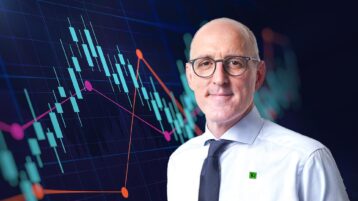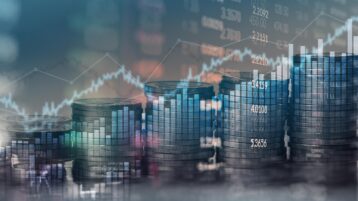As companies look at ways to transition to a low-carbon future, there may be some who are more successful than others. Anthony Okolie speaks with Jing Roy, Portfolio Manager, TD Asset Management, about the importance of green proofing our portfolios to withstand the impact of climate change.
Print Transcript
ANTHONY OKOLIE [00:00:03] Jing, as we transition towards a low carbon economy, why do we need to start thinking about green proofing our investment portfolios?
JING ROY [00:00:11] The urgency to green throughout portfolios boils down to two reasons. First and foremost, climate change is increasing the frequency and severity of adverse weather events. Its impact can be felt far beyond the property values in the regions and spills into the large swath of global economy, including banking and insurance sectors, commodities and supply chains. And a second reason is that to tackle climate change and cut greenhouse gas emissions, governments around the world are putting a price on carbon, which used to be a free commodity. This will challenge the business models of heavy emitters, and at the same time, present attractive investment opportunities for discerning investors.
ANTHONY OKOLIE [00:00:54] So how is climate risk being reflected in asset prices?
JING ROY [00:00:59] We're only just start to price climate risk into different asset classes and this is partially a function of government policy. So investors typically price climate risk more readily in regions that have more stringent and market driven kind of policies. And that's why assets in Europe tend to be more animated to climate risk. Looking ahead, though, pricing climate risk will no longer be a regional phenomenon. So a global carbon market will start to take shape if the carbon border taxes are implemented as proposed by the European Union and the US. And on the other hand, global central banks are trying to assess and incorporate a climate risk into their regulatory frameworks. And this will ultimately change the availability and distribution of credit in the financial system. As a result, climate risk will start to affect asset classes on a global scale.
ANTHONY OKOLIE [00:01:51] OK, so given that, what industries do you think will benefit potentially from this transition to a green economy and what sectors might struggle?
JING ROY [00:01:59] As we transition to net-zero emissions, higher carbon prices will squeeze the margin of heavy emitters of greenhouse gas. There'll be cost pressures for producers of power, cement, metals and chemicals. But among them, regulated utilities are best positioned because they can pass the higher cost onto their customers. And quite a few of them already got a head start on transitioning to renewables. And for banks and insurers, under pricing, climate risk will lead to higher defaults on loans and higher underwriting losses from clients either holding stranded assets or facing high risk of climate hazards. And lastly, in the industrial sector, for every carmaker investing electric vehicles to meet emissions targets, many more are busy building a digital backbone to improve the energy efficiency of their business processes.
ANTHONY OKOLIE [00:02:54] OK, so given this backdrop, this impact on all these different industries. What's your strategy from an investment standpoint? How do you approach it in terms of investing in these sectors?
JING ROY [00:03:04] They're really three ways to green proof an investment portfolio. First, we need to assess and quantify the climate risk in the context of policy direction as well as the climate hazard for every investment we make. And this is especially important for investors holding long life assets such as oil reserves, real estate and infrastructure. Next, we can use alternative assets to mitigate the climate risk inherent in the portfolio. So in the public market, carbon credit is an obvious candidate. The price of carbon will have to go much higher than what it is now for us to deliver on the Paris agreement. And in the private market, investments in high quality carbon offset projects can deliver attractive returns. These alternative assets actually provide an additional benefit of being less correlated with bonds and equity so that investors can enjoy higher returns without having to take on more risk. And lastly, energy transition is becoming an important investment. Besides the more established renewable energy plays, we can invest across capital structure and use structured products to manage the risk of investing in nascent but higher growth opportunities such as new battery technologies, EV charging infrastructure and new materials made from renewable feedstocks.
ANTHONY OKOLIE [00:04:27] So given that, what are the key takeaways for investors going forward?
JING ROY [00:04:31] I would like to leave you with three parting thoughts. Number one, investors can gain an investment edge by making sure that they are appropriately rewarded for the climate risk they take on. A number two, energy transition is a secular theme that brings a vast trove of profitable investment opportunities in the public and private markets. And lastly, what really sets a good investment team apart is its ability to help its client both do good and do well.
ANTHONY OKOLIE [00:05:01] Jing, thank you very much for your insights.
JING ROY [00:05:03] Pleasure.
JING ROY [00:00:11] The urgency to green throughout portfolios boils down to two reasons. First and foremost, climate change is increasing the frequency and severity of adverse weather events. Its impact can be felt far beyond the property values in the regions and spills into the large swath of global economy, including banking and insurance sectors, commodities and supply chains. And a second reason is that to tackle climate change and cut greenhouse gas emissions, governments around the world are putting a price on carbon, which used to be a free commodity. This will challenge the business models of heavy emitters, and at the same time, present attractive investment opportunities for discerning investors.
ANTHONY OKOLIE [00:00:54] So how is climate risk being reflected in asset prices?
JING ROY [00:00:59] We're only just start to price climate risk into different asset classes and this is partially a function of government policy. So investors typically price climate risk more readily in regions that have more stringent and market driven kind of policies. And that's why assets in Europe tend to be more animated to climate risk. Looking ahead, though, pricing climate risk will no longer be a regional phenomenon. So a global carbon market will start to take shape if the carbon border taxes are implemented as proposed by the European Union and the US. And on the other hand, global central banks are trying to assess and incorporate a climate risk into their regulatory frameworks. And this will ultimately change the availability and distribution of credit in the financial system. As a result, climate risk will start to affect asset classes on a global scale.
ANTHONY OKOLIE [00:01:51] OK, so given that, what industries do you think will benefit potentially from this transition to a green economy and what sectors might struggle?
JING ROY [00:01:59] As we transition to net-zero emissions, higher carbon prices will squeeze the margin of heavy emitters of greenhouse gas. There'll be cost pressures for producers of power, cement, metals and chemicals. But among them, regulated utilities are best positioned because they can pass the higher cost onto their customers. And quite a few of them already got a head start on transitioning to renewables. And for banks and insurers, under pricing, climate risk will lead to higher defaults on loans and higher underwriting losses from clients either holding stranded assets or facing high risk of climate hazards. And lastly, in the industrial sector, for every carmaker investing electric vehicles to meet emissions targets, many more are busy building a digital backbone to improve the energy efficiency of their business processes.
ANTHONY OKOLIE [00:02:54] OK, so given this backdrop, this impact on all these different industries. What's your strategy from an investment standpoint? How do you approach it in terms of investing in these sectors?
JING ROY [00:03:04] They're really three ways to green proof an investment portfolio. First, we need to assess and quantify the climate risk in the context of policy direction as well as the climate hazard for every investment we make. And this is especially important for investors holding long life assets such as oil reserves, real estate and infrastructure. Next, we can use alternative assets to mitigate the climate risk inherent in the portfolio. So in the public market, carbon credit is an obvious candidate. The price of carbon will have to go much higher than what it is now for us to deliver on the Paris agreement. And in the private market, investments in high quality carbon offset projects can deliver attractive returns. These alternative assets actually provide an additional benefit of being less correlated with bonds and equity so that investors can enjoy higher returns without having to take on more risk. And lastly, energy transition is becoming an important investment. Besides the more established renewable energy plays, we can invest across capital structure and use structured products to manage the risk of investing in nascent but higher growth opportunities such as new battery technologies, EV charging infrastructure and new materials made from renewable feedstocks.
ANTHONY OKOLIE [00:04:27] So given that, what are the key takeaways for investors going forward?
JING ROY [00:04:31] I would like to leave you with three parting thoughts. Number one, investors can gain an investment edge by making sure that they are appropriately rewarded for the climate risk they take on. A number two, energy transition is a secular theme that brings a vast trove of profitable investment opportunities in the public and private markets. And lastly, what really sets a good investment team apart is its ability to help its client both do good and do well.
ANTHONY OKOLIE [00:05:01] Jing, thank you very much for your insights.
JING ROY [00:05:03] Pleasure.



























